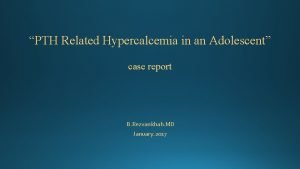Assessment of GeneEnvironment Interaction in Cases of Familial

- Slides: 1

Assessment of “Gene-Environment” Interaction in Cases of Familial & Sporadic Pancreatic Cancer Insert Jefferson Logo Here Theresa Yeo*, Ralph Hruban**, Kieran Brune**, Alison Klein** , Sheila Fitzgerald*** & Charles Yeo* * Department of Surgery and School of Nursing, Thomas Jefferson University, Philadelphia, PA, & **Department of Pathology & ***Bloomberg School of Public Health, The Johns Hopkins University, Baltimore, MD Background: Pancreatic cancer (PC) is the fourth leading cause of cancer death in the United States. Reported risk factors for PC include: advancing age, a family history of PC, high-risk inherited syndromes, cigarette smoking, exposure to occupational and environmental carcinogens, African-American race, high fat/high cholesterol diet, obesity, chronic pancreatitis, and diabetes mellitus. Purpose: The purpose of this study was to characterize one of the largest national registries of familial PC (FPC) and sporadic PC (SPC), focusing on demographics, clinical factors, selfreported environmental and occupational lifetime exposures and survival status. Methods: Retrospective cross-sectional, case-only analysis of FPC cases (n = 569) and SPC cases (n = 689) from the Johns Hopkins National Familial Pancreas Tumor Registry (NFPTR) enrolled between 1994 and 2005. Mean Age at Diagnosis (yrs)a Variable Smokers with no reported ETS exposure (reference group) (n = 81) 63. 8 Smokers with any reported ETS exposure (n = 629) 63. 5 All non-smokers with no reported ETS exposure (reference group) (n = 140) 66. 5 All non-smokers with any reported ETS exposure (n = 364) 64. 0 FPC Non-smokers with no reported ETS exposure (reference group) (n = 62) 66. 6 FPC Smokers with any reported ETS exposure (n = 296) 63. 7 p– valuea Variable No Reported ETS Exposure pvalue 65. 3 (reference) SPC Cases: Mean Age Diagnosis 65. 8 (reference) Odds Ratio Confidence Intervals (95%) pvalue Multiplicat ive Interaction Ever Smoker 0. 86 0. 68 – 1. 09 0. 20 None 1. 16 0. 75 – 1. 80 0. 48 None ETS exposure, bt age 41 - 60 years 1. 31 1. 04 – 1. 65 0. 02* Mild Asbestos 1. 83 1. 31 – 2. 56 <0. 002* Mild Residential Radon 2. 39 1. 39 – 4. 30 <0. 0008* Moderate Welding p = 0. 82 p= 0. 05* Table 3: Unadjusted Multiplicative Interaction between Familial History of PC Compared to Sporadic PC group and Smoking, ETS, Asbestos, and Radon Exposure Variable Mean Age at Diagnosis (years) p= 0. 05* Table 1: Mean Age at Diagnosis of PC if Combined Cigarette Smoking and ETS Exposure FPC Cases: Mean Age Diagnosis Exposure Variable pvalue 0. 75 pvalue Ashkenazi Heritage in sample (n = 169) 65. 1 Ashkenazi FPC Group (n = 75) Ashkenazi SPC Group (n = 94) 66. 4 64. 3 0. 05 Ashkenazi FPC Group: Smokers Non- smokers 64. 4 70. 3 0. 05 Ashkenazi SPC Group: Smokers Non-smokers 63. 8 65. 2 0. 53 Table 4: Mean Age at Diagnosis- Ashkenazi Jews Conclusions • Occupational and environmental exposures may act synergistically with inherited ETS exposure, < age 21 59. 6 0. 001* 56. 7 <0. 0004 a ETS exposure, age 21 -40 61. 2 0. 01* 59. 5 <0. 0004 a ETS exposure, age 41 -60 65. 7 0. 73 66. 9 0. 38 a Table 2: Mean Age at PC Diagnosis Within the FPC and SPC Groups of ETS-Exposed to Non-ETS Exposed Cases or acquired genetic alterations, resulting in earlier occurrence of PC. • Exposure to cigarette smoking and ETS is associated with a younger mean age of diagnosis in FPC and SPC cases and those with an Ashkenazi Jewish heritage, compared to non-exposed cases. • Unaffected individuals from families with history of PC who smoke, have had early life ETS exposure, or have certain occupational and environmental exposures may benefit from screening and early identification of pre-malignant lesions. • Preliminary evidence for an acquired alteration in a genome maintenance or repair gene as the inherited culprit.

